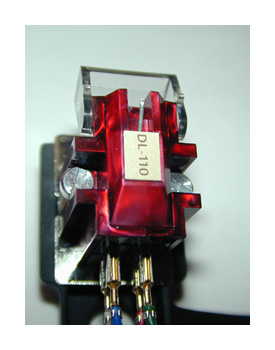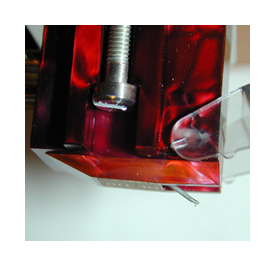You are reading the older HTML site
Positive Feedback ISSUE
15
september/october 2004
denon
DL-110 cartridge
as reviewed by Ed Kobesky

|
ED KOBESKY'S SYSTEM
LOUDSPEAKERS
ELECTRONICS
SOURCES
CABLES
ACCESSORIES |
A few years ago, I ran into a hi-fi dealer at a record show, and we started talking cartridges. "What are you using these days?" he asked. I'll never forget his reaction when I answered—he crumpled his face into the sourest grimace I'd ever seen and emitted a disapproving groan. The cartridge was the Denon DL-160, a polarizing product, as it turns out. How polarizing? Search any online audiophile forum. I did, and quickly found one post describing the DL-160 as "foul sounding," while another said it represents "the best value" in budget cartridges. The venerable, but still viable DL-103 is the subject of even hotter debate. One particularly bad speller characterized DL-103 fans as "saliva drooling morons" and the cartridge as "plane-vanilla," while countless others defended it as an all-time classic.
Venom, bile, disgust—kinda refreshing for a change, huh? We seem to have reached a plateau of sorts in budget hi-fi. You can walk out of nearly any hi-fi store with a pleasant-sounding system for relatively little money, but will the love affair continue after you get it home or will you quickly tire, swapping one homogeneous component for another in a futile search for something special? Denon's high-output cartridges may not be as linear as, say, an Ortofon X1-MC, but they're not boring either. Denon appears to have aimed for a bold sound that is more emotional than neutral. Fine by me—life's too short to suffer with components that sound okay to everyone, but great to no one. By the same token, given the sophistication of today's analog hardware and software, there's no room for deliberately euphonic cartridges. Can there be a happy medium?
Denon's DL-110 and DL-160 are moderately low-compliance designs that share the same cartridge body. Price-wise, they're separated by just $40, selling for $140 and $180 respectively. Frequency response is comparable: 20Hz - 45kHz for the DL-110, 20Hz - 50kHz for the DL-160. The only other apparent differences are cantilever shape (tapered on the DL-160, symmetrical on the DL-110) and stylus profile (0.07 x 0.1 on the DL-160 vs. the DL-110's 0.1 x 0.2 diamond). The DL-110's 1.6mV output is sufficient to feed any standard moving magnet phono input. While 1.6mV may sound a bit low on paper, it provided more than enough oomph for the MM section of my NAD integrated amp. In fact, the DL-110 will probably overload a typical MC phono section. Those accustomed to moving magnet designs will find the DL-110 easy to accommodate, if not easier.

With its arrow-straight parallel sides, the DL-110 may look blocky and old-fashioned, but the shape is a boon for setting overhang and azimuth. The cantilever on my sample was straight and true, something you can't always count on in this price range. If you insist on aligning the cartridge body and not the cantilever itself, you'll probably squeak by. Further easing setup is the most robust mounting hardware I've seen in this price range. Unfortunately, while the higher-priced DL-160 comes with an assortment of nuts and bolts, the DL-110 is delivered with a single set. A metal weight is supplied to help balance the lightweight 4.8-gram cartridge on certain tonearms. You'll also find an overhang gauge (for use with Denon turntables) and a decent stylus brush that should do the trick for those who avoid fluid-based cleaners. Finally, the DL-110 includes a handy flip-down stylus guard. You'll have no worries about accidentally snuffing the cantilever during mounting. Some owners probably remove it entirely before LP playback, but I didn't. It seemed like it might be a tricky procedure, and the guard provides protection against overenthusiastic cleaning ladies and curious kids.
Transitioning from most low-priced cartridges to the DL-110 is like going from a boom box to a surround sound system. As with most high-output moving coils, you'll want to allow the DL-110 a few hours to settle down. It's wiry, stiff, shrill and grating when factory fresh, but after about ten hours of seasoning it begins to sound very much like its big brother—startlingly open and spacious, with a deep soundstage, smooth shimmering highs, and surprisingly powerful bass. Case in point is No Doubt's Rock Steady (Interscope 06949 3158-1). The lowest notes surrounded me like an Imax movie. With my eyes closed, I could imagine the soundstage extending in a wide arc, yet vocals and guitars remained tightly focused up front.
Listening to Dire Straits' Love Over Gold (PolyGram 1-3317) revealed nuances most budget cartridges leave unresolved. I could sense the sublime physical interaction between finger and string that lets you know it's being plucked by a real live human being. Cymbals, which can sound sizzly or canned on lesser cartridges, were eerily realistic. The layering of instruments was also superb, with everything in its correct place and plenty of elbow room between them. On more densely packed music like Saint Saens' Symphony No. 3 performed by the Chicago Symphony Orchestra under Daniel Barenboim (Deutsche Grammophon 2530619), the DL-110 deftly balanced the delicacy of quiet passages with room-shaking bursts of organ that weren't dramatically or dynamically compromised. As you'd expect at this price level, there was some congestion, but far less than you might imagine. I believe the limiting factors were more likely my tonearm and amplifier than the DL-110.
I've read at least one other review that alludes to the DL-110's "broadcast balance." This is not surprising when you consider that the DL-110's grandfather, the DL-103, is a broadcast cartridge. Cue up Wes Montogomery's Full House (Original Jazz Classics OJC-106) or Classic Records' 180-gram reissue of Harry Belafonte Sings the Blues (RCA LSP-1972), and you'll immediately appreciate its heritage. The added bloom and spaciousness bring you one step closer to sharing space with the performers. Of course, some LPs are beyond help, and the DL-110 couldn't breathe life into my U.S. pressing of The Who's classic Who's Next (MCA 2023). It's so dynamically challenged that you'd be forgiven for thinking it was mastered using a portable cassette recorder. It did sound a bit more open with the Denon than with either of my previous cartridges, the Shure M97xE and the Ortofon X1-MC. That's not saying much, though.
Before you assume the DL-110 is a "gimmick" cartridge, intended solely for people seeking a certain unique set of characteristics, listen closely to its sweet tonal balance. Zero in on the natural decay. Pay attention to the way all that extra ambience animates each note. And finally, luxuriate in lightning-quick transients that make crescendos a soul-stirring experience, not the buildup to a letdown. If your system needs spicing up, but not at the expense of refinement, the DL-110 could be just the ticket. It's fast and articulate enough to surpass most similarly priced cartridges. Given the DL-110's other strengths, its timing is also superb. In addition, vocals were as natural as any I've heard, be it Alison Krauss, Frank Sinatra, or Lyle Lovett. Voices were downright spooky, so if that's your priority, I can't imagine a better $140 cartridge than the DL-110.
Naturally, your choice of arm and turntable will influence the DL-110's performance. Though I haven't tried it on multiple turntables, I have done so with the sonically similar DL-160. Working from memory, the DL-160 sounded detailed but bright on a Denon DP-47F. It shone on the Rega P2, sounding smooth, big and precise. On a mass market Luxman PD284, it managed to get most details across, but was somewhat hampered by that turntable's average arm and cost-conscious construction. On my current Technics SL-1200 Mk2, the DL-110 offers a bold, spacious, and dynamic yet vaguely businesslike presentation.
I've come to regard any cartridge that can negotiate the first two bias tracks on side one of the HiFi News Test Record as an average tracker. If it can ace band three, it's well above average. For the record, at a 2-gram tracking force and anti-skate setting, the DL-110 sailed right through the first three tracks without complaint and distorted evenly in both channels on the torture track. That makes it exceptional in its price range. Though this is somewhat counterintuitive, the DL-110 is a surprisingly good match for the low-mass arm on my Technics 'table, which is said to be on the high side of low mass. The DL-110 is on the moderate end of low compliance, which partially explains the result.
But who cares? What I really want to know is, when I play Billy Joel's The Nylon Curtain (Columbia QC 38200), will the chorus of "Goodnight Saigon" turn to dirt during the loud refrain ("… and we will all go down together")? The song is on the innermost band, the toughest to track, and I've come to accept plenty of congestion and distortion when playing it, even if I align the cartridge to favor the inner grooves. Luckily, there was no need to skew the Denon DL-110's geometry. For the first time in a long time, I heard the song without audible mistracking and precious little distortion.
 The DL-100's
"special
elliptical stylus" reaches deeper into the grooves than ordinary
profiles. That's a blessing for used record buyers, since it bypasses
the damage typically caused by worn styli and ham-fisted setup. If
you've never owned a very detailed cartridge, you'll probably be
surprised by how much quieter your non-mint LPs sound. On the downside,
proper setup is more crucial with the DL-110, which means it may not be
ideal for beginners. Take the time to get it right and you'll be
rewarded. Wing it and you'll never experience its full potential.
The DL-100's
"special
elliptical stylus" reaches deeper into the grooves than ordinary
profiles. That's a blessing for used record buyers, since it bypasses
the damage typically caused by worn styli and ham-fisted setup. If
you've never owned a very detailed cartridge, you'll probably be
surprised by how much quieter your non-mint LPs sound. On the downside,
proper setup is more crucial with the DL-110, which means it may not be
ideal for beginners. Take the time to get it right and you'll be
rewarded. Wing it and you'll never experience its full potential.
The DL-110 treads exceptionally lightly on my prized LPs. It has a nimble way of tracing that makes some other cartridges sound like lumbering steamrollers. The DL-110's suspension glides like a Sedan DeVille over heavily modulated passages and slight warps.
The Denon DL-110 is a winner. Setup is fuss-free and tracking superb. After a brief break-in period, it goes about its business with an ease and refinement that belies its modest price. If you've been wondering why many audiophiles prefer moving coil designs, you'll find some enlightenment here, but be forewarned—unlike most beer-budget cartridges, the DL-110 exhibits genuine character. Its bigger-than-life sound isn't quite "neutral" and certainly not "warm," but in an age when so many entry-level components are recommendable but bland, isn't it nice to know there's at least one affordable product you'll either love or hate? Ed Kobesky
Denon
web address: www.usa.denon.com
